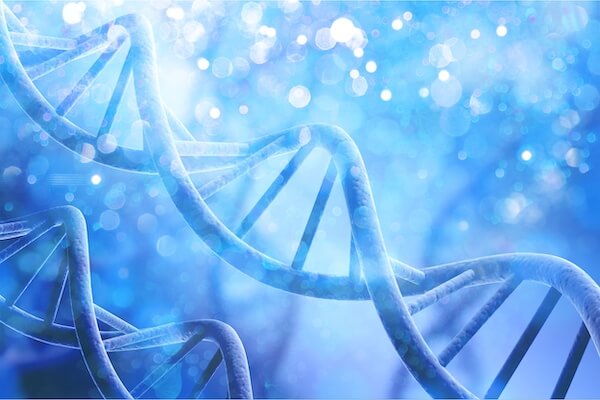Human Genes are Turned On and Off by Diet
 This article originally appeared in the September 2013 McDougall Newsletter.
This article originally appeared in the September 2013 McDougall Newsletter.
By John McDougall, MD
Scientists once believed that genetic information was fixed at the time of fertilization, and therefore was beyond any outside influences. This has been found to be untrue. Good genes are “turned on” by a healthy environment, just as “bad genes” are silenced by a healthy environment. In practical terms “a healthy environment” means a diet based on a plentiful supply of starches, vegetables, and fruits (avoiding animal-derived foods and oils). The biochemistry involved is complex, but may be of interest to you.
Genetics is the study of heredity in general and genes (DNA) in particular. Changes in genes occur only over long periods of time (measured in tens of thousands of years) through evolution, whereas expression of the information stored in our genes changes rapidly and is affected by pressures from the outside environment. Epigenetics is the study of these timely adaptations. (The Greek prefix epi- in “epigenetics” refers to biologic changes that occur that are “on top of” or “in addition to” those directed by our basic set of genes that we inherit from our parents.)
Reading the Genetic Code
The most fundamental form of epigenetics accounts for our entire development. Life begins with genetic information from the father (sperm) and the mother (egg) joining together to form a fertilized egg; thereby the basic genetic code for a person is established. Within this one cell is all the information required to grow all the parts of a baby, including perfectly formed hair, a nose, lips, a heart, and two legs. To accomplish this remarkable differentiation during the development of the embryo, specific segments of the genetic code (DNA) either become active or remain silent at specific times within specific cells. For a nose to grow on a child’s face, the “nose genes” in a few embryonic cells must be turned on while unrelated genes are turned off. Exactly how these precisely orchestrated events play out is still a mystery.
How different genes are expressed is also the result of changes in our environment. This plasticity of our genetic material has been clearly demonstrated by “twin studies.” Identical twins begin life as a single fertilized egg that splits into two with identical genes in each egg. If the expression of our genetic code were fixed then identical twins would remain identical throughout life. They would develop similarly and go on to have the same health issues. However, that is not what is observed. Furthermore, as twins age, their DNA actually becomes more dissimilar. The differences are even more apparent when twins are raised in distinctly different environments (this happens when they are separated after birth, for example).
Diet-induced Epigenetic Changes Are Also Inherited
Epigenetic changes that appear in sperm or egg cells prior to fertilization can be transferred to subsequent generations. For example, the effects of severe starvation that took place in the German-occupied Netherlands during the Dutch famine of WWII (1944–1945) were subsequently seen in following generations of Dutch children. Epigenetic changes that allowed a pregnant mother to survive on 580 calories a day for six months appeared in their offspring. In essence, “thrifty genes” were turned on in the fetus in preparation for survival during very lean times. Unfortunately, this enhanced efficiency turned out to be detrimental because post-WWII were times of plenty in Western Europe, with an abundance of meat, dairy products, cakes, and cookies.
Daughters born to mothers starved during the Dutch famine were found to have even higher risks of diseases typically caused by over-nutrition. They had over twice the risk of breast cancer, more hypertension, and developed heart disease three years sooner than daughters born to mothers who were well nourished during pregnancy. In line with adaptations made to survive in a world of food scarcity, the daughters born to “starved” mothers were also found to be more capable of reproduction than girls born to mothers who were well nourished. Prolific reproduction enhances survival of the species.
Another example of the influences of food shortages on epigenetic changes is provided by the study of several generations of people from Overkalix, Sweden. Records show that during the years of 1800, 1812, 1821, 1836 and 1856 there was total crop failure followed by extreme suffering. However, 1801, 1822, 1828, 1844 and 1863 were years of food abundance. Not surprisingly, Swedish men exposed during preadolescence to the periods of famine were less likely to die of cardiovascular disease. What was surprising is that similar advantages were passed on to the next generations. Grandsons (of once starving men) were at one-fourth the risk of developing type-2 diabetes, and died on average six years later in life than the grandsons of fathers who were well nourished during a similar time in life.
These differences in the health of offspring from the Dutch and Swedish famines may seem to be contradictory: Mothers pregnant during lean times passed on epigenetic changes that harmed their daughters in times of plenty, whereas fathers passed on changes that seemed to help their grandsons, even though these offspring also ate a rich diet. Adequate explanations for the different outcomes are not available, but both observations point to the fact that sudden changes in the environment (the availability and type of food) can cause rapid changes in gene expressions that are remembered and passed down to subsequent generations.
Epigenetics in Times of Over-Nutrition
We now live in a world where diseases caused by over-nutrition are far more common than diseases of under-nutrition (starvation). Based on observations from times of under-nutrition, we can expect that our bodies are efficiently making epigenetic changes that will enhance the human race. Genes are being turned on to deal with excesses of fat, protein, cholesterol, and environmental chemicals; all at levels never before faced by past populations. Although epigenetic changes may blunt the impact of all this toxicity, they cannot compensate fully. And as before, these adaptations will be passed on to subsequent generations with unknown results to their health.
Fortunately, modifications in gene expression now being caused by over-nutrition are reversible. Studies of people and laboratory animals have identified many chemicals found in foods that result in both helpful and harmful gene expressions. Not surprisingly, plants make beneficial chemicals. For example, folate from plants causes favorable epigenetic changes. For maximum benefit and minimal risk, this natural chemical must be consumed in the right package—like a bean or banana—not as a pill.
Folate-deficiency causes birth defects (neural tube defects), so the obvious solution would be to enrich a reproductive woman’s diet with foliage (plants)—the natural source of folate. Instead, women have been told to take folic acid pills before pregnancy, and the food supply in many countries has been supplemented (folic acid is added to flours and cereal products). Folic acid supplied in this manner, as an isolated concentrated nutrient, results in fewer birth defects but offers no added protection against the risk of death, cancer, and heart disease for the general population.
Animal foods, such as meat, poultry, cheese, milk, and eggs are well recognized as the primary cause of obesity, heart disease, and common cancers in people following the Western diet. Choline, a chemical found in high concentration in animal foods, has profound effects on gene expression and is considered to be an important factor in our modern-day diseases.
Finally, calorie-restricted diets have been shown to result in epigenetic changes that are associated with weight loss, and a reduced risk of developing diabetes, heart disease, and cancers. Other than by involuntary starvation (as seen with the Danes and Swedes), the natural, appetite-satisfying, health-enhancing way to restrict calories is to replace meat, dairy, and oils in the diet with starches (beans, corn, potatoes, rice, etc.), vegetables, and fruits.
The science of epigenetics is new and interactions between our environment and our genes are complex. But we know enough about epigenetics to stem the tide in the rise of obesity, heart disease, and cancers for people living in western societies for now and the future. Proper nurturing (by health-supportive foods) will bring out the best in our genes. The fact that the vast majority of people have survived successfully on plant- (more exactly, starch-) based diets for all of verifiable human history should be sufficient evidence for us to make the right food choices now.
Recommended Articles

Giving Thanks

Can Exercise Lower Cholesterol?







